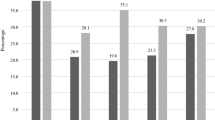Abstract
Population Studies Center, University of Michigan, Ann Arbor, Michigan 48109 Abstract-This paper addresses the question of whether the crude birth rate (CBR) can be used as a proxy for more refined fertility measures in cross-national models of fertility determinants. It responds to a recent claim that the CBR represents an inappropriate fertility measure for these purposes. In the analysis, several strategies are used to assess the degree to which results based on the CBR are sensitive to lack of adjustment for age structure. The paper concludes that using the CBR as a proxy has minor and unimportant effects upon conclusions regarding fertility determinants.
Similar content being viewed by others
References
Adelman, I. 1963. An Econometric Analysis of Population Growth. American Economic Review 53:314–338.
Agency for International Development. 1978. World Fertility Patterns. Washington, D.C.: United States Agency for International Development, Office of Population.
Anker, R. 1978. An Analysis of Fertility Differentials in Developing Countries. Review of Economics and Statistics 60:58–69.
Barclay, G. W. 1958. Techniques of Population Analysis. New York: Wiley.
Beaver, S. E. 1975. Demographic Transition Theory Reinterpreted: An Application to Recent Natality Trends in Latin America. Lexington~ MA: Lexington Books.
Bogue, D. J. and J. A. Palmore. 1964. Some Empirical and Analytic Relations AmongDemographic Fertility Measures with Regression Models for Fertility Estimation. Demography 1:316–338.
Bollen, K. A. 1980. Comparative Measurement of Political Democracy. American Sociological Review 45:370–390.
Cho, L. J. 1964. Estimated Refined Measures of Fertility for All Major Countries of the World. Demography 1:359–374.
Coale, A. J. 1972. The Growth and Structure of Human Populations. Princeton, NJ: Princeton University Press.
Cochrane, S. H. 1979. Education and Fertility: What Do We Really Know? Baltimore: The Johns Hopkins University Press.
Cohn, R. M. 1980. Economic Development and the Status of the Aged. Center for Demography and Ecology Working Paper 80-8. The University of Wisconsin, Madison, Wisconsin.
Entwisle, B. 1981. Crude Rates in Cross-National Fertility Research. Research Report 81-6. Population Studies Center, University of Michigan, Ann Arbor.
Entwisle, B. and K. Bollen. 1981. Pension Programs: An Indirect Means to Fertility Reduction. Research Report 81-8. Population Studies Center, University of Michigan, Ann Arbor.
Entwisle, B. and C. R. Winegarden. 1981. Fertility and Pension Interrelationships in Developing Countries: Econometric Evidence. Research Reports 81-9. Population Studies Center, University of Michigan, Ann Arbor.
Friedlander, S. and M. Silver. 1967. A Quantitative Study of the Determinants of Fertility Behavior. Demography 4:30–70.
Gregory, P. and J. Campbell, Jr. 1976. Fertility and Economic Development. Pp. 160–187 in M. Keeley (ed.), Population, Public Policy, and Economic Development. New York: Praeger.
Guest, A.M. 1974. The Relationship of the Crude Birth Rate and Its Components to Social and Economic Development. Demography 11:457–472.
Heer, D. M. 1966. Economic Development and Fertility. Demography 3:423–444.
Hohm, C. F. 1975. Social Security and Fertility: An International Perspective. Demography 12:629–644.
Janowitz, B. 1971. An Empirical Study of the Effects of Socioeconomic Development on Fertility Rates. Demography 8:307–317.
Johnston, J. 1972. Econometric Methods. 2nd Edition. New York: McGraw-Hili Book Company.
Kasarda, J. D. 1971. Economic Structure and Fertility: A Comparative Analysis. Demography 8:307–317.
Kirk, D. 1979. World Population and Birth.Rates: Agreements and Disagreements. Population and Development Review 5:387–403.
Mauldin, W. P., B. Berelson, and Z. Sykes. 1978. Conditions of Fertility Decline in Developmg Countries. Studies in Family Planning 9:89–147.
Palmore, J. A. 1978. Regression Estimates of Changes in Fertility, 1955–60 to 1965–75, for Most Major Nations and Territories. Papers of the East-West Population Institute, Number 58.
Piazza, T. 1980. the Analysis of Attitude Items. American Journal of Sociology 86:584–603.
Stolnitz, G. J. 1955. Uses of Crude Vital Rates in the Analysis of Reproductivity. Journal of the American Statistical Association 50:1215–1234.
Weintraub, R. 1962. The Birth Rate and Economic Development. Econometrica 40:812–817.
World Bank. 1978. World Development Report 1978. Washington, D.C.: World Bank.
Author information
Authors and Affiliations
Rights and permissions
About this article
Cite this article
Entwisle, B. CBR versus TFR in cross-national fertility research. Demography 18, 635–643 (1981). https://doi.org/10.2307/2060952
Issue Date:
DOI: https://doi.org/10.2307/2060952




